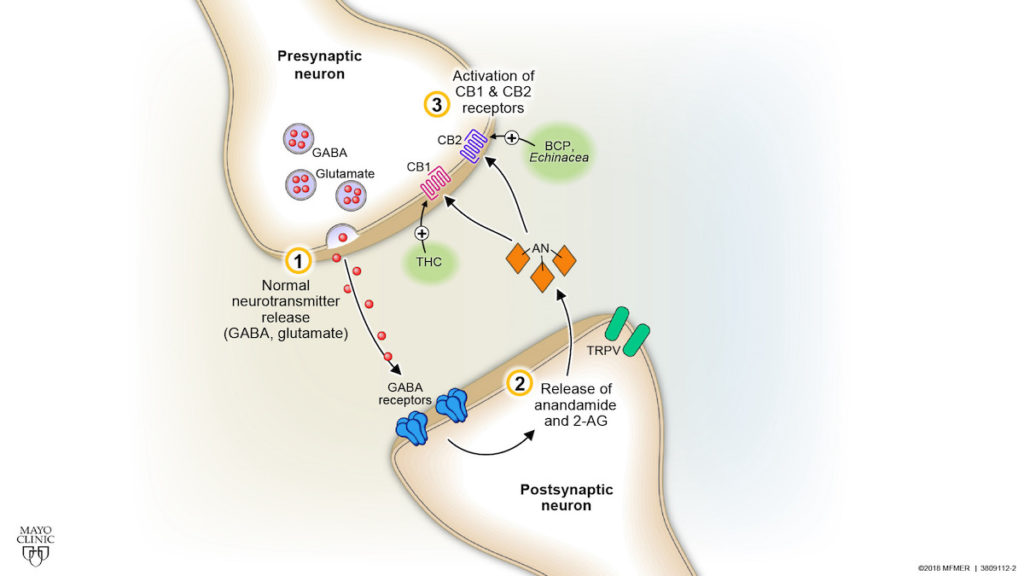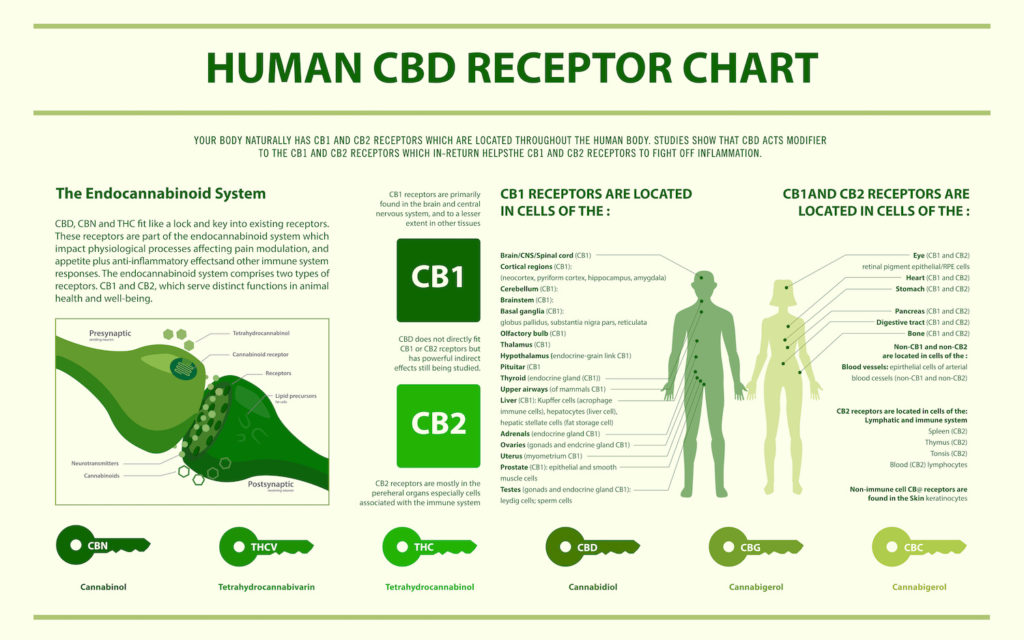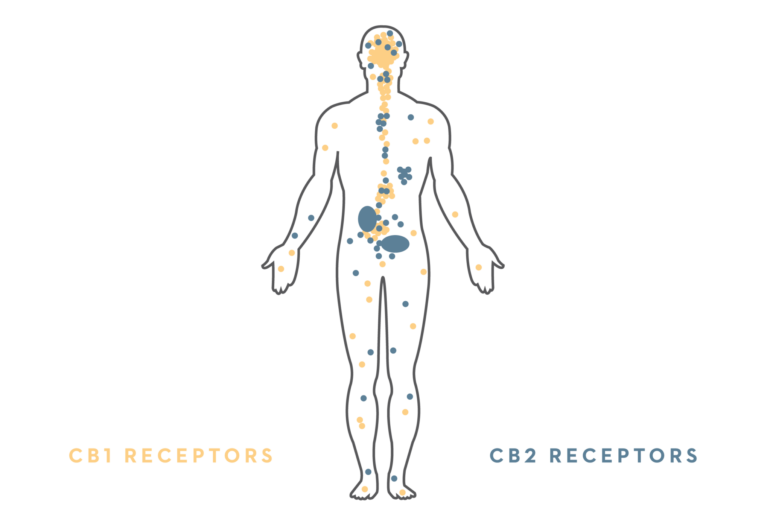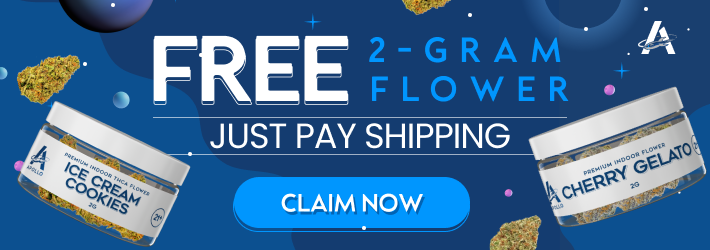If I throw the terms “cannabinoid receptor”, “homeostasis”, “2-AG”, or “anandamide” at you, I’m pretty sure you’ll look back at me in total confusion. The fun (but frustrating) thing about the endocannabinoid system (ECS) is it’s complex and quite dense in terms of the amount of info you need to digest.
However, it’s totally worth diving into! You realize just how important this system is, especially when you look at how cannabis and cannabis-related products interact with your body’s physiological makeup.
Everything you need to know about the ECS:
- Your ECS is a naturally-occurring biological system responsible for regulating core physiological functions
- The core functions include but not limited to mood, sleep, memory, temperature, and stress.
- All mammals have an ECS — humans, dogs, cats, parrots, etc.
- Phytocannabinoids (CBD, THC) interact with your ECS
- There’s a theory that your ECS can under-perform, causing you certain conditions and syndromes
Let’s look at how your ECS works, how it helps your body find balance, and what you can do to keep it healthy and functioning.
What is the endocannabinoid system (endogenous cannabinoid system) and how does it work?
First, let’s look into what the endocannabinoid system (ECS) actually is.
On a basic level, the ECS is a naturally-occurring biological system found in every single mammal on earth. You have one, your mom has one, your dad has one — even your pet dog, cat, rat, and parrot has one.
Your ECS is composed of three core components:
- Cannabinoid receptors
- Endocannabinoids (eCBs)
- Enzymes
These three components all work together to bring your body to a state of physiological balance by regulating and maintaining your physiological functions — this, by definition, is what’s known as homeostasis.
But how do they all work inside of you?

You first have cannabinoid receptors. These receptors sit on top of your cells and can be found all throughout your body. They observe or “listen out” for any physiological changes or imbalances and make sure everything is in working order. These changes or imbalances can be a number of things, be it inflammation, temperature change, etc.
The two main cannabinoid receptors found in your body are cannabinoid receptor 1 (CB1) and cannabinoid receptor 2 (CB2) — very original names, huh?
When your receptors realize something’s amiss or they notice a physiological change, an appropriate call to action is sent out via signals. These signals will encourage endocannabinoid production in the right area e.g. if you have back pain, your endocannabinoids will be sent there.
Once your endocannabinoids find their target, they will bind to the appropriate cannabinoid receptor (CB1 or CB2 depending on where in the body) and stay there until they’ve got the job done. Once everything is back normal, your metabolic enzymes will clear the endocannabinoids to make sure they don’t overstay their welcome.
The core functions your ECS maintains and regulates
The beauty of your ECS is it’s believed to help regulate a vast number of different physiological functions in order to achieve consistent homeostasis — though there’s still much more research needing to be done for this to be 100% conclusive.
So far, studies show the ECS helps regulate:
- Mood
- Stress
- Pain
- Sleep
- Immune (inflammation) response
- Motor control
- Cognitive function (thought)
- Memory
- Appetite
- Body temperature
- Bone growth
- Protection of nerves and brain tissue
Cannabinoid receptors are located throughout your body

Endocannabinoid receptors are located in many parts of your body. You’ll find them in the brain, central nervous system (CNS), connective tissues, organs (peripheral or otherwise), and the immune system.
However, cannabinoid receptors aren’t lumped into one category. There are two different receptor subtypes: CB1 and CB2.
CB1 receptors can be found in many parts of the brain, specifically the prefrontal cortex, hippocampus, amygdala, and basal ganglia, as well as the central nervous system (CNS). You’ll also find them in peripheral organs such as the spleen and liver, as well as the endocrine glands as part of your reproductive, gastrointestinal, and urinary tract. This is why cannabinoids have an effect on motor control and pain regulation.
CB2 receptors, on the other hand, are found in higher numbers throughout the immune system. When activated, they show promise in providing your body with anti-cancer and anti-inflammatory benefits. Similar to CB1, you’ll also find CB2 in some parts of the brain but at lower levels.
CB1 receptors
- Prefrontal cortex (brain)
- Hippocampus (brain)
- Amygdala (brain)
- Basal ganglia (brain)
- Cerebellum (brain)
- Central nervous system (CNS)
CB2 receptors
- White blood cells
- Immune system
- Nervous system
- Tonsils
- Spleen
- Gastrointestinal/digestive system
When was the endocannabinoid system discovered?
You’ll be surprised to learn the ECS is a relatively new discovery in comparison to how early cannabis-related research began. In 1988, two esteemed scientists, Allyn Howlett and William Devan, discovered cannabinoid receptor sites in the brains of rodent test subjects.
Fast-forward two years and the first cannabinoid receptor was officially uncovered in rats and humans. By 1993, the second cannabinoid receptor was uncovered. Since then, a broad range of research has been conducted on how the endocannabinoid system works, how each component interacts with each other, and how phytocannabinoids from varieties of cannabis works in conjunction with it.
How does cannabidiol (CBD) interact with your ECS?
Many believe CBD has the ability to bind with your endocannabinoid receptors, but this isn’t strictly true. In fact, CBD doesn’t really bind with either the CB1 or CB2 receptors. Instead, it influences the receptors in a way that is still somewhat unknown to researchers.
However, we do know CBD interacts with your own endocannabinoids to increase the likelihood of them binding to your receptors (both CB1 and CB2).
Ongoing research indicates a wide range of cellular mechanisms associated with CBD and the ECS. Specific cellular targets include neurons, endothelial cells, oligodendrocytes, and microglial cells. CBD appears to stimulate synaptic plasticity and facilitates neurogenesis that may explain its positive effects on attenuating psychotic, anxiety, and depressive behaviors.
CBD also acts as a CB1 “agonist”, whereby it inhibits the receptor’s activity. As we mentioned earlier, CB1 is the receptor THC “binds” to. Therefore, there’s scope to suggest CBD suppresses THC when it attaches itself to the CB1 receptor, negating some of its intoxicating effects.
So, I guess you’re now thinking, “what does CBD actually bind to then?”.
Well, CBD is actually quite successful at having a close relationship with other receptor sites. Two main ones include:
Vanilloid (TRVP1)
The TRVP1 vanilloid receptor is pretty interesting actually. Notice its name is similar to “vanilla”? It’s not a coincidence. This receptor can produce effects similar to the vanilla bean. How? Because vanilla beans contain special essential oils known for their anti-inflammatory and analgesic essential qualities.
Therefore, when you ingest CBD, it interacts with your vanilloid receptors, which helps your body with pain and, of course, inflammation.
5-hydroxytryptamine (5HT1A)
At high levels, CBD is known to activate 5HT1A, which is the receptor that produces serotonin. If you don’t know what serotonin is, it’s often referred to as the “happy chemical”. It’s said to reduce depression and aid anxiety symptoms. It’s commonly found in your digestive system and throughout your central nervous system.
Scientific studies vouched for the efficacy 5HT1A had on neurobehavioral disorders of rats leading them to see it mirroring positive effects against anxiety and depression in humans as well as fighting neurological disorders.
How does tetrahydrocannabinol (THC) interact with your ECS?
There are over 60 known phytocannabinoid compounds found in varieties of cannabis. Some of these compounds have been identified as acting uniquely on both CB1 and CB2 receptors separately and simultaneously — or, rather, inhibit or activate receptor functions.
THC is actually better at binding with your endocannabinoid receptors than CBD (mainly CB1) due to its shape and size. Because THC can bind effectively to CB1 receptors (and sometimes CB2), it produces an oftentimes strong “high” or “otherworldly” feeling.
The activation of these signaling pathways by CB1 receptors and the high levels of these receptors on presynaptic terminals indicates that endocannabinoid stimulation of CB1 receptors suppresses neuronal excitability and inhibits neurotransmission.
This, in turn, completely overwhelms your ECS and throws it out of balance.
There are three main types of cannabinoids (and they’re not all the same thing!)

1. Phytocannabinoids (made in plants)
Phytocannabinoids are chemical compounds found in varieties of cannabis. In fact, they’re specifically found in the cannabis plant’s trichomes. Wondering what trichomes are? They’re microscopic mushroom-esque growths located on the leaves and buds of your cannabis strains — they almost look like a bed of tiny crystals covering the plant.
The most common phytocannabinoids are THC and CBD (I’m sure you’ve already heard of these before!). When you consume phytocannabinoids, they interact with your endocannabinoid system (specifically the receptors).
2. Endogenous cannabinoids (made in body)
Here’s a brain-bender for you. Endogenous cannabinoids are often referred to as cannabinoids made in your body, but this isn’t technically true. They’re actually endogenous “particles” produced naturally in your body similar to the phytocannabinoids you consume — most notably CBD and THC.
Let’s take a look at this in more detail below.
Endocannabinoid #1: Arachidonoyl ethanolamide (anandamide)
The name “anandamide” is derived from the Sanskrit word ananda meaning “bliss” or “divine joy”, which makes total sense really if you think of how anandamide affects your mind and body. It’s the endocannabinoid with the closest similarity to THC and is produced in high quantities when THC “binds” to your CB1 receptor.
Anandamide is produced in certain areas of your brain and throughout your central nervous system (CNS). It’s also responsible for the “runner’s high” after physical exertion e.g. running, working out, etc. This runner’s high has often been compared to a mild high after cannabis has been consumed. Pretty cool, right? So, next time you feel amazing after a run (or something similar), you’ll know why!
Endocannabinoid #2: 2-arachidonoyl glycerol (2-AG)
2-AG is another endocannabinoid (or, rather, endogenous “particle”) produced in your body. Unlike anandamide, 2-AG binds to both CB1 and CB2 receptors — in fact, CBD helps 2-AG bind to these two receptors.
2-AG’s role in your endocannabinoid system is equally as important as anandamide’s. It’s believed to help support the regulation and maintenance of your digestive system (specifically your appetite) and immune system, as well as combating pain-related symptoms. Researchers also believe 2-AG can benefit your circulatory system and reduce the frequency of epileptic seizures.
As a side note, 2-AG’s activation of CB1 receptors is known to lower anxiety, which is amazing news for all you anxiety sufferers out there. This shows how powerful your ECS is.
However, the power your ECS produces doesn’t get the credit it deserves. Pharmaceutical companies, for example, assign most of the credit to the anti-anxiety drugs they produce, as opposed to praising their interaction with your ECS and its receptors. I personally believe we should be giving credit where credit is due.
Other lesser-known and under-studied endocannabinoids include:
- Homo-gamma-lineleoul ethanolamide
- Docosatetraenoul ethanolamide (DEA) Docosatetraenoyl Ethanolamide
- Noladin ether (2-AGE)
3. Synthetic cannabinoids (made in lab)
Synthetic cannabinoids (otherwise known as synthetic marijuana or “fake weed”) are often seen as the devil’s alternative to natural phytocannabinoids. They’re man-made cannabis substitutes and are designed to mimic the functions of THC insofar as binding to the same cannabinoid receptors. This, in turn, provides you with quite a substantial “high”.
However, synthetic cannabinoids should be approached with a high level of caution i.e. it’s better to stay the hell away from them for the most part, especially away from a laboratory. They were originally only designed for researchers to explore and understand the functions and effects of cannabinoids — they certainly weren’t designed to be used recreationally.
In fact, synthetic cannabinoids are 30 times more harmful than your regular (and natural!) cannabis strains. Many users report increased, and oftentimes intense, anxiety and paranoia, as well as powerful psychotic episodes.
When your endocannabinoid system under-performs
So, what happens if you have a dysfunctional or under-performing ECS? Well, right now, science doesn’t 100% know yet. Researchers are still trying to figure this one out. The theory is if your endocannabinoid system fails to perform its duties correctly, you’ll experience resulting symptoms, conditions, and illnesses.
One study believes a potential endocannabinoid deficiency—also referred to as Clinical Endocannabinoid Deficiency (CED)—can be the cause of treatment-resistant syndromes such as:
- Migraines
- Fibromyalgia
- Irritable Bowel
The researchers of this study believe the ECS oftentimes needs only a “pharmacological nudge, rather than a forceful shove, by synthetic full agonists”. In other words, small doses of controlled synthetic cannabinoids are said to be useful here, particularly THC alongside CBD and other cannabinoids for synergistic benefits.
Beyond this, the researchers also believe cannabinoid use in conjunction with low impact exercise is vital to an increase in ECS functionality.
There are ways to stimulate your endocannabinoid system
Even though Clinical Endocannabinoid Deficiency (CED) is only a theory thus far, it’s interesting to know there’s some scope to suggest an under-performing ECS can be attributed to a number of physiological conditions.
I think it’s worth airing on the side of optimism here and entertaining the idea that CED is a real thing. With this in mind, here are some ways to boost your ECS:
- Consume foods rich in omega-3 and omega-6 fatty acids
- Consume chocolate (mainly dark chocolate)
- Exercise frequently
- Consume cannabidiol (CBD)
So, what’s best? CBD or THC?
It’s easy for me to sit here and say, “well, THC is the best because I like to get high and reap all the benefits THC puts into my mind and body”. But this won’t help you because it’s a personal preference and not specific to what you’re trying to achieve for yourself.
So, let’s look at it this way.
THC is far more beneficial if you’re a) happy and comfortable with achieving a certain level of intoxication b) looking for a cannabinoid that helps tackle pain (mild, severe, or otherwise), insomnia, nausea, or low appetite.
CBD, on the other hand, is completely non-intoxicating, so you never have to worry about getting high. It’s far more accessible to a larger user base. CBD is best taken for general relaxation and milder physical, physiological, or psychological symptoms, especially in oil or capsule form.
If you want a more effective CBD product, try out CBD concentrates ready to be dabbed with a specialized dab rig or just CBD-rich hemp flower. The act of inhalation is far better for absorption into the body.
Notice I haven’t mentioned anything about anxiety? There’s a reason for that.
If you’re suffering from anxiety or anxiety-related symptoms, you need to tread carefully. Too much THC consumption can make you spiral out and cause . It’s actually better to take a combination of both CBD and THC — CBD will help balance out the intoxicating effects of THC. A cannabis flower or oil with a 1:1 CBD:THC ratio will do just the trick.

